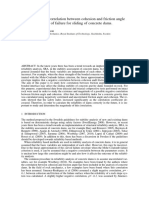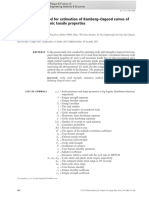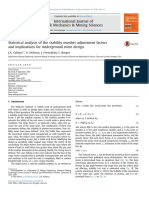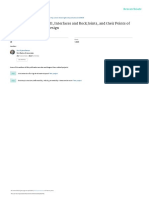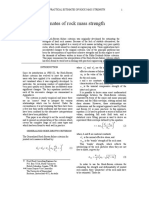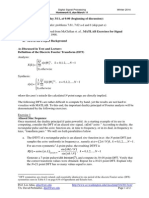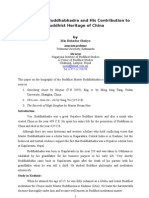Point Load Index Test For The Indication of The Directional Strength Behaviour of Soft Sedimentary Rocks
Point Load Index Test For The Indication of The Directional Strength Behaviour of Soft Sedimentary Rocks
Uploaded by
hkhcsbCopyright:
Available Formats
Point Load Index Test For The Indication of The Directional Strength Behaviour of Soft Sedimentary Rocks
Point Load Index Test For The Indication of The Directional Strength Behaviour of Soft Sedimentary Rocks
Uploaded by
hkhcsbOriginal Description:
Original Title
Copyright
Available Formats
Share this document
Did you find this document useful?
Is this content inappropriate?
Copyright:
Available Formats
Point Load Index Test For The Indication of The Directional Strength Behaviour of Soft Sedimentary Rocks
Point Load Index Test For The Indication of The Directional Strength Behaviour of Soft Sedimentary Rocks
Uploaded by
hkhcsbCopyright:
Available Formats
Point Load Index Test for the Indication of the Directional Strength
Behaviour of Soft Sedimentary Rocks
Ronald Haselsteiner, Christoph Hartmann, Alexander Schmitt, Burkhard Reingen
Björnsen Consulting Engineers, Koblenz
Experimental Preparation /Rig is(50)
The point load index test is a simple test for The point load index is often related to a load
estimation of rock parameters. A specimen of point distance of 50 mm (equation 3).
rock is fixed between two platen pointed and ,
∙ (3)
pressure is until break. The peak applied load
is recorded and used to calculate the Point
Load Index. The experiment can be used Broch (1983) is reporting that the point load
directly on site to determine the point load index is a reliable tool for investigating the
strength of drilling cores. A sketch of the test rig directional strength behaviour of also soft to
is shown in figure 1. medium rocks. The strength reduction is
strongest for load direction angles α = 30 - 60°
referring to the foliation/stratification. Parallel to Diagram 1. Results of the point load tests with different angle of
the foliation/stratification the obtained values load evaluated for siltstone and shale and both (BCE 2014)
are weaker (α = 90°).
Example: Rhine Slate
Two types of rocks were tested, siltstone and
shale. For each rock type six classes of the load
direction were defined in table 2.
Table 2. Classification according to the load angle (BCE 2014))
Figure 1. Picture of a point load test rig device (Avantech
Engineering Consortium Pvt, 2015)
Diagram 2. Results of the point load test evaluated for the
Point Load Index iS [kN/m²] different load angles. (BCE 2014)
The Point Load Index iS is defined as the 106 tests with different load angles were carried
quotient of the breaking force FB [kN] and the out of which only 94 results have shown a clear
corresponding area of the specimen A [m²] and comprehensible break behaviour. The
(equation 1) (Thuro, 2010). The corresponding specimen were one and a half years old, so the
area is depending on the type of failure and is test could not reflect the in-site conditions
to be determined after the failure according to (water content). The strongest value was
the failure/breaking mode. measured at an angle of α = 0° and the weakest
(1) value was measured at an angle of α = 50° -
70° (Table 3).
The uniaxial compressive strength UCS* Table 3. Test results of rock samples (siltstone and shale) of the
Rhine slate. (BCE 2014)
(= σ*u) [kN/m²] Diagram 3. Point load index for all results and separate for
siltstone and shale in the comparison for different classes of
load angles. (BCE 2014)
The dimensionless factor c describes the
correlation between the Point Load Index and References
Akram, M.; Bakar, M. Z. A. 2007. Correlation between uniaxial Compressive
Uniform Compressive Strength in form of a Strength and Point Load Index for Salt-Range Rocks. Pak. J. Eng. & Appl.
linear curve (equation 2). The empirical Sci, Vol. 1.
correlation factor c is depending on Avantech Engineering Consortium Pvt 2015. Ltd. Digital Point Load Testing
geotechnical conditions (e.g. the rock type). System(PLT-100) URL:
http://www.avantech.in/library/images/products/5c86159c-cb15-4ade-8c2e-
Table 1 shows different values for the factor c. ad849c3fb78a.jpg
BCE 2014. Point load test on the Rhine shale – report. Björnsen Consulting
∗ ∗
σ c∙ (2) Engineers, Koblenz, Germany (unpublished)
Table 1. Factor c values (Broch & Franklin 1972) The test results document a distinct load angle Broch, E.; Franklin, J. A. 1972. The point load strength test. International
Journal of Rock Mechanics and Mining Science & Geomechanics Abstract,
dependent point load index. Relative strong 9, pp. 669-697.
values were obtained perpendicular and parallel Broch, E. 1983. Estimation of Strength Anisotropy Using the Point-Load Test.
to the foliation/stratification, lowest values Int. J. Rock Mech Min Sci. & Geomech. Abstr., Vol. 30, No. 4, pp. 181-187.
resulted at load angles of α = 30 – 60°. Mark C, Molinda GM. 1996. Rating Coal Mine Roof Strength from
Corresponding to the roughness of the shear Exploratory Drill Core. In the Proceeding of the 15th International
Conference on Ground Control in Mining, Golden CO, 1996, pp. 415-428.
surface the weakest shear strength is not
Rusnak, J,; Mark, C. 2000. Using the point load test to determine the uniaxial
obtained for loads parallel to the foliation but compressive strength of coal measure rock. 19th Ground Control
parallel to the roughness pattern (see diagram 1 Conference in Mining, West Virginia University, Proceedings, pp. 362-371.
to 3) . Thuro, K. 2010. Empfehlung Nr. 5 „Punktlastversuche an Gesteinsproben“
des Arbeitskreises 3.3 „Versuchstechnik Fels“ der Deutschen Gesellschaft
für Geotechnik. Bautechnik 87 (2010), Heft 6, S. 322-330
You might also like
- Smart Form PO SummaryDocument13 pagesSmart Form PO SummaryYanamala Manjunatha Reddy100% (2)
- Rock11-Bearing Capacity of Strip Footings On Jointed Rock MassesDocument3 pagesRock11-Bearing Capacity of Strip Footings On Jointed Rock Masseshana saffanahNo ratings yet
- Point Load Chau - K - T - and - Wong - R - H - C - 1996 - Uniaxial - CoDocument6 pagesPoint Load Chau - K - T - and - Wong - R - H - C - 1996 - Uniaxial - CoMOLOBALY DIT MAHAMADOU DEMBELENo ratings yet
- Ada 397047Document59 pagesAda 397047dulassmavieNo ratings yet
- The Influence of Correlation Between Cohesion and Friction Angle On The Probability of Failure For Sliding of Concrete DamsDocument6 pagesThe Influence of Correlation Between Cohesion and Friction Angle On The Probability of Failure For Sliding of Concrete DamsAjaysingh PatilNo ratings yet
- Stress-Intensity Factors ForDocument19 pagesStress-Intensity Factors ForMaria Camila RestrepoNo ratings yet
- Strength Criterion For Rocks Under Compress - 2015 - Journal of Rock Mechanics ADocument6 pagesStrength Criterion For Rocks Under Compress - 2015 - Journal of Rock Mechanics ASEDIMNo ratings yet
- Basal Stability of Braced Excavations in K - Consolidated Soft Clay by Upper Bound MethodDocument7 pagesBasal Stability of Braced Excavations in K - Consolidated Soft Clay by Upper Bound Methodkulbrsingh4975No ratings yet
- Practical Estimates of Rock Mass Strength 97 PDFDocument24 pagesPractical Estimates of Rock Mass Strength 97 PDFNicolás SilvaNo ratings yet
- Hoek-Brown Failure Criterion - 2002 Edition: January 2002Document9 pagesHoek-Brown Failure Criterion - 2002 Edition: January 2002Borja Garcia AmealNo ratings yet
- Practical Rock Engineering Chapter 4 Shear Strength of DiscontinuitiesDocument14 pagesPractical Rock Engineering Chapter 4 Shear Strength of DiscontinuitiesKaren MkNo ratings yet
- Pushover Analysis of RC Building: Neethu K. N., Saji K. PDocument4 pagesPushover Analysis of RC Building: Neethu K. N., Saji K. PTezinNo ratings yet
- International Journal of Mechanical Sciences: J.H. Song, H. HuhDocument13 pagesInternational Journal of Mechanical Sciences: J.H. Song, H. HuhMowazzem HossainNo ratings yet
- 2002 Hoek Brown Failure Criterion - 230331 - 183154Document8 pages2002 Hoek Brown Failure Criterion - 230331 - 183154Vicente BeizaNo ratings yet
- Barton - Shear Strength Criteria For Rock, Rock Joints, Rockfill and Rock Masses - Problems and Some Solutions - 2012Document13 pagesBarton - Shear Strength Criteria For Rock, Rock Joints, Rockfill and Rock Masses - Problems and Some Solutions - 2012krainaoz2011No ratings yet
- Cope, R.J. & Rao P.V. (1983), Moment Redistribution in Skewed Slab BridgesDocument30 pagesCope, R.J. & Rao P.V. (1983), Moment Redistribution in Skewed Slab BridgesM KraNo ratings yet
- Tests On Rocks: Soil MechanicsDocument5 pagesTests On Rocks: Soil MechanicsWaqas Sadiq100% (1)
- Bearing Capacity of Circular Footings Under Surcharge UsingDocument13 pagesBearing Capacity of Circular Footings Under Surcharge UsingOum MahmdNo ratings yet
- Point Load Test On Schistose Rocks and Its Applicability in Predicting Uniaxial Compressive StrengthDocument6 pagesPoint Load Test On Schistose Rocks and Its Applicability in Predicting Uniaxial Compressive StrengthalgifarieidzamNo ratings yet
- Load and Resistance Factor Design Approach For Fatigue of Marine StructuresDocument6 pagesLoad and Resistance Factor Design Approach For Fatigue of Marine Structurespushloop1243No ratings yet
- Shear Strength of Rockfill, Interfaces and Rock Joints, and Their Points of Contact in Rock Dump DesignDocument15 pagesShear Strength of Rockfill, Interfaces and Rock Joints, and Their Points of Contact in Rock Dump DesignThomas LawsonNo ratings yet
- Determination of Mohr Cou Lombs Hear Strength ParametersDocument8 pagesDetermination of Mohr Cou Lombs Hear Strength ParametersSammy Davis Lucano PoloNo ratings yet
- Determination OF OF Forces IN TIE AND JIB OF A Simple Crane" Simple "JIBDocument5 pagesDetermination OF OF Forces IN TIE AND JIB OF A Simple Crane" Simple "JIBNiaz Khan22No ratings yet
- Materials Science and Engineering A: Determination of Strain-Hardening Exponent Using Double Compression TestDocument3 pagesMaterials Science and Engineering A: Determination of Strain-Hardening Exponent Using Double Compression TestRAGHUKUMAR SNo ratings yet
- Eberhardt (2015) ISRM Suggested Method Por Failure Criteria - Hoek-BrownDocument13 pagesEberhardt (2015) ISRM Suggested Method Por Failure Criteria - Hoek-BrownSebastian Jorquera HenriquezNo ratings yet
- Kriteria Keruntuhan Mohr ColoumbDocument8 pagesKriteria Keruntuhan Mohr ColoumbIrwandi PakpahanNo ratings yet
- Cyclic Load Test of PileDocument7 pagesCyclic Load Test of Pilesurajitkundu2002100% (1)
- Damage Assessment of Square RC Bridge Columns Subjected To Torsion Combined With Axial Compression, Flexure, and ShearDocument10 pagesDamage Assessment of Square RC Bridge Columns Subjected To Torsion Combined With Axial Compression, Flexure, and Shearishaq AllalNo ratings yet
- Ako Daraei-2019Document14 pagesAko Daraei-2019rahul khannaNo ratings yet
- An Improved Method For Estimation of Ramberg-Osgood Curves Ofsteels From Monotonic Tensile PropertiesDocument15 pagesAn Improved Method For Estimation of Ramberg-Osgood Curves Ofsteels From Monotonic Tensile PropertiesAsad MaqsoodNo ratings yet
- Issues in Evaluating Capacity of Rock Socket FoundationsDocument11 pagesIssues in Evaluating Capacity of Rock Socket FoundationspaducoNo ratings yet
- Deformation Analysis For Prestressed Concrete Beams: by J. WarwarukDocument14 pagesDeformation Analysis For Prestressed Concrete Beams: by J. WarwarukRahil QureshiNo ratings yet
- Agaiby Mayne 2018 Evaluating Rigidity Index of Clays From Piezocone - CPT18 DelftDocument6 pagesAgaiby Mayne 2018 Evaluating Rigidity Index of Clays From Piezocone - CPT18 Delftchin_kbNo ratings yet
- Icsmge 2022-65Document7 pagesIcsmge 2022-65fraztyaNo ratings yet
- Widodo PDFDocument5 pagesWidodo PDFreluNo ratings yet
- 1 s2.0 S0267726120301007 Main PDFDocument13 pages1 s2.0 S0267726120301007 Main PDFIBARRA FARIAS JOAQUIN ALEJANDRONo ratings yet
- Evert Hoek Carlos Carranza-Torres Brent Corkum: Ci CiDocument7 pagesEvert Hoek Carlos Carranza-Torres Brent Corkum: Ci CiAnonymous v1blzDsEWANo ratings yet
- Intact Rock Part 2Document2 pagesIntact Rock Part 2cerdycelosoalejaga2No ratings yet
- Sexton 2014Document13 pagesSexton 2014Sidali RafaNo ratings yet
- 1997 - Hoek & Brown - Practical Estimates of Rock Mass StrengthDocument25 pages1997 - Hoek & Brown - Practical Estimates of Rock Mass StrengthNanu Karunia100% (1)
- Shear Strength of Rockfill Interfaces and Rock JoiDocument17 pagesShear Strength of Rockfill Interfaces and Rock JoiAlexandre RibeiroNo ratings yet
- Rock Blasting 11Document29 pagesRock Blasting 11Alvaro Andres Bustamante Montenegro100% (1)
- Statistical Analysis of The Stability NumberDocument9 pagesStatistical Analysis of The Stability Numberroger jhonarNo ratings yet
- Shear Strength of Rockfill Interfaces and Rock JoiDocument17 pagesShear Strength of Rockfill Interfaces and Rock JoiRodrigo De MeloNo ratings yet
- Concept of Blastability - An Update: Kaushik Dey & Phalguni SenDocument15 pagesConcept of Blastability - An Update: Kaushik Dey & Phalguni SenDanny Achahue0% (1)
- M1P1 1140 PDFDocument7 pagesM1P1 1140 PDFKunwarKhaliqeAhmadNo ratings yet
- The Incremental Rigidity Method - More-Direct Conversion of Strain To Into Internal Force in An Instrumented Static Loading TestDocument13 pagesThe Incremental Rigidity Method - More-Direct Conversion of Strain To Into Internal Force in An Instrumented Static Loading TestLuz Virginia Suárez QuinteroNo ratings yet
- Correlation Between Point Load Index and Very Low Uniaxial Compressive Strength of Some Iraqi RocksDocument14 pagesCorrelation Between Point Load Index and Very Low Uniaxial Compressive Strength of Some Iraqi RocksGbenga AdewumiNo ratings yet
- ABS Fatigue Paper PDFDocument8 pagesABS Fatigue Paper PDFFandy SipataNo ratings yet
- Fracture Mechanics of Concrete Structures Proceedings FRAMCOS-3 AEDIFICATIO Publishers, D-79104 Freiburg, GennanyDocument10 pagesFracture Mechanics of Concrete Structures Proceedings FRAMCOS-3 AEDIFICATIO Publishers, D-79104 Freiburg, GennanyAleksandra CubrinovskaNo ratings yet
- Shear Strength of Rockfill Interfaces and Rock JoiDocument16 pagesShear Strength of Rockfill Interfaces and Rock JoiDaniel MoravanskýNo ratings yet
- Hoek and Brown - Practical Estimates of Rock Mass Strength PDFDocument24 pagesHoek and Brown - Practical Estimates of Rock Mass Strength PDFChenthuran VilvarajahNo ratings yet
- RockMassStrength From Parameters Rev 0Document8 pagesRockMassStrength From Parameters Rev 0Ari FNo ratings yet
- 7240 7 Foundation On Rock1Document21 pages7240 7 Foundation On Rock1jmg.godsell12No ratings yet
- Hoek-Brown 파괴기준-2Document7 pagesHoek-Brown 파괴기준-2xmlnzkNo ratings yet
- Direct Shear Test On Sand ASTM D 3080Document6 pagesDirect Shear Test On Sand ASTM D 3080Muhammad ImranNo ratings yet
- Geotechnical Criterion For Serviceability Limit State of Horizontally-Loaded Deep FoundationsDocument14 pagesGeotechnical Criterion For Serviceability Limit State of Horizontally-Loaded Deep FoundationsArun PhakadeNo ratings yet
- Sharma 1998Document6 pagesSharma 1998arjunNo ratings yet
- Issues in Evaluating Capacity of Rock Socket Foundations KULHAWY and PRAKOSODocument11 pagesIssues in Evaluating Capacity of Rock Socket Foundations KULHAWY and PRAKOSOErisvaldo de LimaNo ratings yet
- Reviews in Computational ChemistryFrom EverandReviews in Computational ChemistryAbby L. ParrillNo ratings yet
- Method Statement For Construction of Sewerage Manhole MH8.5 Connecting To Existing Sewer Lines RevDocument10 pagesMethod Statement For Construction of Sewerage Manhole MH8.5 Connecting To Existing Sewer Lines RevhkhcsbNo ratings yet
- Form CIDB IBS Score M1 2018Document11 pagesForm CIDB IBS Score M1 2018hkhcsbNo ratings yet
- TOD and Market Feasibiltiy Study For Real Estate DevelopmentDocument75 pagesTOD and Market Feasibiltiy Study For Real Estate DevelopmenthkhcsbNo ratings yet
- Rekabentuk IBS - Eastern PretechDocument127 pagesRekabentuk IBS - Eastern PretechhkhcsbNo ratings yet
- Construction Basic Price 2019Document4 pagesConstruction Basic Price 2019hkhcsb100% (1)
- Core Concepts and Issues FinalDocument88 pagesCore Concepts and Issues FinalhkhcsbNo ratings yet
- All-In Rates (Structure)Document3 pagesAll-In Rates (Structure)hkhcsbNo ratings yet
- Settlement AnalysisDocument3 pagesSettlement AnalysishkhcsbNo ratings yet
- Xypex Megamix IDocument2 pagesXypex Megamix IhkhcsbNo ratings yet
- Plastocrete N: Safety Data SheetDocument7 pagesPlastocrete N: Safety Data SheethkhcsbNo ratings yet
- Engine Truck SpecsDocument1 pageEngine Truck SpecshkhcsbNo ratings yet
- Sika Microcrete-217Document3 pagesSika Microcrete-217hkhcsbNo ratings yet
- Sma - DBKL SpecsDocument19 pagesSma - DBKL SpecshkhcsbNo ratings yet
- Column Interaction Diagram Units: KN, KN-M: English MetricDocument5 pagesColumn Interaction Diagram Units: KN, KN-M: English MetrichkhcsbNo ratings yet
- DLL - MAPEH 4 - Q4 - W8 - New@edumaymay@lauramos@angieDocument8 pagesDLL - MAPEH 4 - Q4 - W8 - New@edumaymay@lauramos@angieDonna Lyn Domdom PadriqueNo ratings yet
- Webb Neneh Esh310 At2Document36 pagesWebb Neneh Esh310 At2api-296441201No ratings yet
- Part of Fortune in 8th HouseDocument3 pagesPart of Fortune in 8th HousetratakNo ratings yet
- Kunst Ethnomusicology 1955Document164 pagesKunst Ethnomusicology 1955Andrea Castro BNo ratings yet
- Alokverma V Union of IndiaDocument11 pagesAlokverma V Union of IndiaskvaleeNo ratings yet
- Gideon v. Cochran:Gideon v. WainwrightDocument6 pagesGideon v. Cochran:Gideon v. Wainwrightbarredowl100% (1)
- She's A Trash Prince's SisterDocument1,406 pagesShe's A Trash Prince's SisterEvey ReisNo ratings yet
- Digital EntrepreDocument10 pagesDigital EntrepreMillyNo ratings yet
- American Humanist Association Letter To Roselle ParkDocument10 pagesAmerican Humanist Association Letter To Roselle ParkSergio R. BichaoNo ratings yet
- The Assam Tribune DT - 10-06-2024Document12 pagesThe Assam Tribune DT - 10-06-2024dekatina37No ratings yet
- CA IPCC Costing & FM Quick Revision NotesDocument21 pagesCA IPCC Costing & FM Quick Revision NotesChandreshNo ratings yet
- 2019-High Temperature Oxidation Resistance of Ni P and Ni B Electroless Coatings On Mild Steel After Long Term TestsDocument8 pages2019-High Temperature Oxidation Resistance of Ni P and Ni B Electroless Coatings On Mild Steel After Long Term TestsSandra AriasNo ratings yet
- Systematic ApproachDocument28 pagesSystematic Approachapi-317191678100% (1)
- Physical Test On OPCDocument16 pagesPhysical Test On OPCসন্দীপ চন্দ্রNo ratings yet
- Chapter 1: Offers & SuggestionsDocument3 pagesChapter 1: Offers & SuggestionsMuhammad SahirNo ratings yet
- Carroll, Karanja Keita - The Black Campus Movement - An Interview With Ibram H. RogersDocument9 pagesCarroll, Karanja Keita - The Black Campus Movement - An Interview With Ibram H. RogersDionisio MesyeNo ratings yet
- GC Links I YearDocument16 pagesGC Links I YearMonicaMartirosyanNo ratings yet
- Historical Dictionary of Fantasy Literature PDFDocument567 pagesHistorical Dictionary of Fantasy Literature PDFsonuvuce100% (1)
- HW 8 Matlab ProblemDocument2 pagesHW 8 Matlab Problemjoe.kurina31940% (1)
- A Note On BuddhabhadraDocument10 pagesA Note On BuddhabhadraMin Bahadur shakya100% (1)
- ASTM 2016 B230 - B230M - 07 (Reapproved 2016)Document5 pagesASTM 2016 B230 - B230M - 07 (Reapproved 2016)javad4531No ratings yet
- Chapter 9 - Benefit Cost AnalysisDocument23 pagesChapter 9 - Benefit Cost AnalysisEric MikleinNo ratings yet
- Exploring The Diagnostic Capability of RTA Type CurvesDocument17 pagesExploring The Diagnostic Capability of RTA Type CurveshunterextremeNo ratings yet
- Business Advantage Upper-Intermediate Sample Unit - Students BookDocument8 pagesBusiness Advantage Upper-Intermediate Sample Unit - Students BookWild Billy Barker GahanNo ratings yet
- Operation Research (Study Material)Document105 pagesOperation Research (Study Material)Shivam Kashyap0% (1)
- Case Press Ob WardDocument9 pagesCase Press Ob Wardjohn castroNo ratings yet
- Medical Books List For DownloadingDocument5 pagesMedical Books List For DownloadingasifNo ratings yet
- Derivational RelationsDocument3 pagesDerivational RelationsElizabeth EckelNo ratings yet
- About Ziauddin UniversityDocument3 pagesAbout Ziauddin Universityaamrah_mangoNo ratings yet




